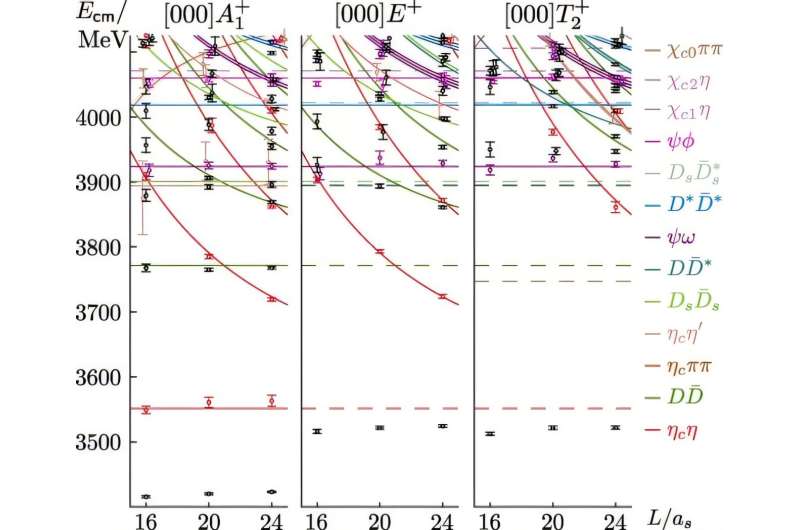An elusive particle that first formed in the hot, dense maelstrom of the early universe has puzzled physicists for decades. Following its surprise discovery in 2003, scientists began observing a slew of other strange objects tied to the millionths of a second after the Big Bang.
Appearing as “bumps” in the data from high-energy experiments, these signals came to be known as short-lived “XYZ states,” for lack of a better label. They defy the standard picture of particle behavior and are a leading problem in contemporary physics, sparking several attempts to understand their mysterious nature.
But theorists at the U.S. Department of Energy’s Thomas Jefferson National Accelerator Facility suggest that the experimental data could be explained with fewer XYZ states, also called resonances, than currently claimed.
Representing Jefferson Lab’s Center for Theoretical and Computational Physics and the U.K.’s Cambridge University, the researchers used a branch of quantum physics to compute the energy levels—also known as mass—of particles containing a certain “flavor” of the subatomic building blocks known as quarks.
The team found that multiple particle states sharing the same degree of spin (angular momentum) are coupled, meaning only a single resonance exists at each spin channel. This fresh interpretation is contrary to several other theoretical and experimental studies.
“We would advocate that we’re more likely to get to an understanding of the experimental spectrum if the data are combined into a coupled-channel analysis,” said Jozef Dudek, a Jefferson Lab staff scientist and professor at the College of William & Mary. “Our hypothesis is that the approach might end up reducing the number of resonances needed to explain all the data.”
Dudek and his Theory Center colleagues presented their results in a pair of companion papers published for the international Hadron Spectrum Collaboration (HadSpec) in Physical Review Letters and Physical Review D. The exciting work could also soon provide clues about a perplexing particle with an enigmatic name: X(3872).
The charm of X(3872)
The charm quark, one of six quark “flavors,” was first observed experimentally in 1974. It was discovered alongside its antimatter counterpart, the anticharm, and particles paired this way are part of an energy region called “charmonium.”
Fast forward to 2003, and the Belle experiment at the High Energy Accelerator Research Organization (KEK) in Japan discovered a new charmonium candidate dubbed X(3872). Its cryptic name conjures images of interstellar objects such as exoplanets, but X(3872) is a short-lived particle state that appears to defy the present quark model.
Some scientists claim X(3872) could be a tetraquark, which is a composite particle (hadron) made up of two quarks and two antiquarks. For comparison, protons and neutrons are hadrons with three quarks. Other possible explanations for X(3872) include a molecule-like bound system of two mesons, each containing two quarks, or some sort of quark-gluon hybrid.
“X(3872) is now more than 20 years old, and we still haven’t obtained a clear, simple explanation that everyone can get behind,” said David Wilson, a Jefferson Lab scientific user from the U.K.”s University of Cambridge and the lead author on the HadSpec study.
Other exotic candidate states have been observed, such as Y(4260) and Zc(3900); hence the label XYZ. In fact, so many states were being discovered that in 2017, the Particle Data Group revamped its naming scheme.
This hodgepodge of excited states is the result of an explosion in the amount of data captured by modern particle accelerators.
“High-energy experiments began measuring processes that are hundreds of times fainter,” Dudek said. “They started seeing bumps, interpreted as new particles, almost everywhere they looked. And very few of these states agreed with the model that came before.”
The “XYZ” alphabet soup motivated the HadSpec group to begin sorting the spectra of states using quantum field theory.

Spectra in irreps Λ𝑃=𝐴+1, 𝐸+, and 𝑇+2 with zero overall momentum, having leading 𝐽𝑃𝐶=0++, 2++ and 2++ partial waves respectively. Points are the computed finite-volume energies colored according to their dominant operator overlap, with colors given in the key on the right. Black points have large overlap with both 𝑐𝑐-like and 𝐷¯𝐷-like operators. Solid curves indicate noninteracting meson-meson energies and dashed lines indicate kinematic thresholds. Degenerate noninteracting levels are indicated by multiple parallel curves, slightly displaced in energy for visual clarity. © Physical Review Letters (2024). DOI: 10.1103/PhysRevLett.132.241901
From the lattice
Quantum chromodynamics (QCD) describes quarks’ interactions with gluons, the photon-like carriers of the strong force. Supercomputers, with their ability to crunch huge numbers of numbers, can be applied to QCD by placing the theory on a lattice.
Think of the lattice as a small, tightly packed grid of points representing space and time. Theorists can use the possible configurations of quarks and gluons inside this “box” to predict properties of hadrons such as their masses and lifetimes.
The lattice box is tiny, with dimensions of 2 to 3 femtometers—nearly a million times smaller than a single atom. But even such a tiny volume requires an enormously powerful computer to sample the possible behaviors of quarks and gluons. That’s why the HadSpec group used several high-performance computing clusters, including those at Jefferson Lab, to perform the mind-boggling math.
“If you hated calculus in school, just imagine the worst calculus problem ever,” Dudek said.
The HadSpec group computed the masses and lifetimes of mesons in the charmonium region, where XYZ states have been claimed in experiments. These mesons decay rapidly into “D mesons” and their antimatter counterparts.
D mesons consist of a charm quark, which is heavy, and a lighter antiquark of the flavors “up,” “down” or “strange.” Anti-D mesons are the exact opposite: They contain an anticharm quark and an ordinary quark of one of those lighter flavors.
If you’re wondering where the extra quarks are coming from, QCD predicts vacuum fluctuations in which quark-antiquark pairs are constantly created and annihilated. These phenomena are a long-theorized quantum quirk of empty space.
“Somewhere along the line, at least one pair of light quarks must have come into existence,” Dudek said. “They weren’t there when you had a charm-anticharm just buzzing around, but they are there in this well-separated, D-meson pair.”
The authors used the lattice results to infer all the possible ways in which the charmonium mesons could decay. To do this, they had to relate the results from a tiny box to what would happen in a virtually infinite volume—that is, the size of the universe.
“In our calculations, unlike experiments, you can’t just fire in two particles and measure two particles coming out,” Wilson said. “You have to simultaneously calculate all possible final states, because quantum mechanics will find those for you.”
The results can be understood in terms of just a single short-lived particle (a resonance) whose appearance could differ depending upon which possible decay state it is observed in.
“We’re trying to simplify the picture as much as possible, using fundamental theory with the best methods available,” Wilson said. “Our goal is to disentangle what has been seen in experiments.”
Now that the HadSpec team has proved this type of calculation is feasible, they are ready to apply it to the mysterious particle X(3872).
“X(3872) is quite interesting,” Wilson said. “Its origin is an open question. It appears very close to a threshold, which could be accidental or a key part of the story. This is one thing we will look at very soon.”
More information:
David J. Wilson et al, Scalar and Tensor Charmonium Resonances in Coupled-Channel Scattering from Lattice QCD, Physical Review Letters (2024). DOI: 10.1103/PhysRevLett.132.241901
David J. Wilson et al, Charmonium χc0 and χc2 resonances in coupled-channel scattering from lattice QCD, Physical Review D (2024). DOI: 10.1103/PhysRevD.109.114503
Provided by
Thomas Jefferson National Accelerator Facility
Citation:
Lattice QCD method suggests a simpler spectrum of exotic XYZ hadrons (2024, November 12)



